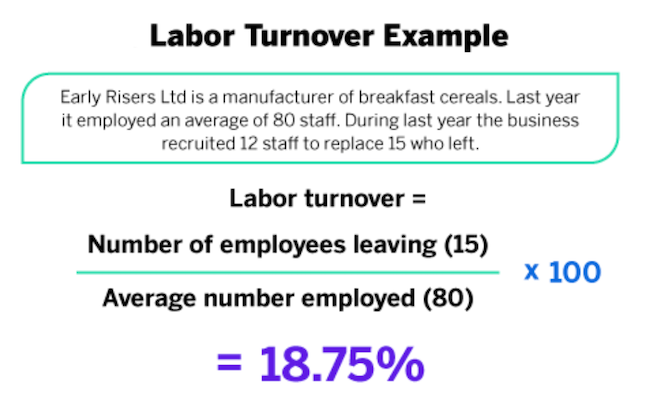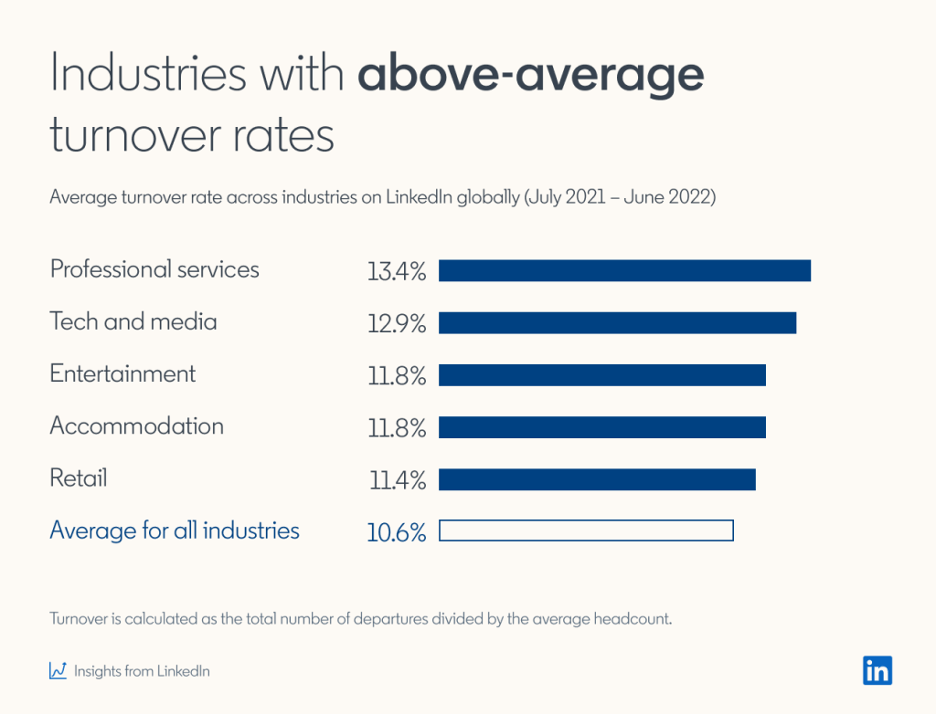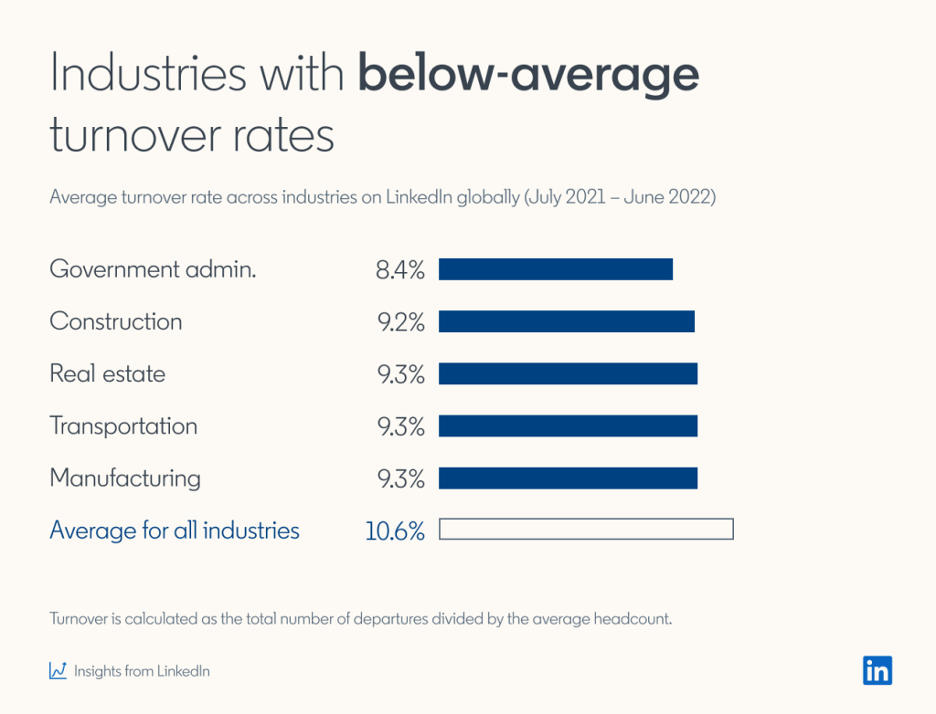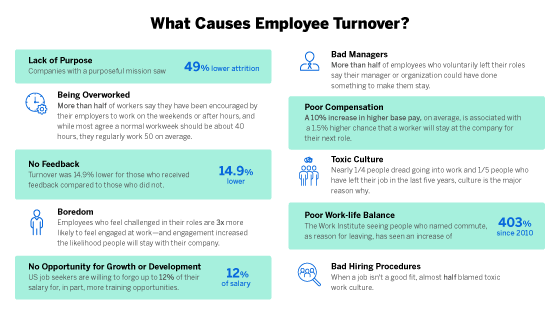With 44% of people saying they’ll look for a new job in the next year, as a result of The Great Resignation, organizations have to do the groundwork. You’ll need to take a long, hard look at your retention strategies and provide employees with the tools and support they need to do their jobs efficiently and manageably – wherever they’re working.
Free eBook: 2025 employee experience trends
What is employee turnover?
Employee turnover is what happens when employees leave – either of their own accord or being asked to leave, perhaps following poor performance, dissolution of their role, or other organizational changes.
Hiring is expensive, and losing people can disrupt organizational performance. An excessive employee turnover rate is linked with low morale and customer churn, which are both expensive and undesirable. So it’s little wonder that employee turnover is generally viewed as an unconditional negative in business.
But employee turnover is both normal and necessary. Careers progress, life changes, and businesses grow and adapt their company vision and strategy over time. A company with a very low employee turnover rate and the same employees year after year would quickly stagnate and fail.
The key to maintaining a healthy and sustainable employee turnover rate is to focus on retention as a means of reducing unwanted turnover.
Having an employee experience (EX) program is a valuable way to stay ahead of undesirable turnover. It allows you to proactively focus on the drivers of retention, rather than reactively attempting damage control when qualified employees are already partly or completely out of the door.
The 6 types of employee turnover
It can be helpful to differentiate between kinds of employee turnover since they can have very different effects on your business and employee retention. There are six main types, with voluntary turnover and involuntary turnover probably the best known:
1. Voluntary employee turnover
When an employee chooses to leave a job. Voluntary turnover can include new hires who may be no-shows, employees who have found another job, left for personal reasons, returned to education, joined the military, moved away, or simply left because they didn’t like the job or other team members.
2. Involuntary employee turnover
When an employee is made to leave a job. They may be a poor performer (particularly during a probationary period), come up with an unsatisfactory background check; there may have been a violation of company policy, misconduct, or insubordination, are laid off due to lack of work or are a poor fit for the company culture.
3. Retirement
The employee has reached the end of their working life and takes a well-earned break. There is no negative reason for retirement – the employee has not gone to a competitor (just yet) and there is probably plenty of goodwill.
4. Internal transfer
A valuable employee has been promoted or moved to another department within the organization. Well done – you’ve retained a good employee.
5. Functional employee turnover
Poor performers leave the organization – they are not asked to leave, but do so because they feel they are at the end of their road too.
6. Dysfunctional employee turnover
Top talent leaves your organization – they may have been poached by a competitor for better pay and job role, or they may have requested working conditions or concessions and had them refused.
Turnover can be voluntary or involuntary, and it can be desirable or undesirable. These possibilities can be combined with one another in either direction. For example, voluntary turnover can be undesirable (when a high performer leaves) or desirable turnover (when a low performer leaves).
Calculate your employee turnover rate
Monitoring employee turnover is one of the mainstays of human resources, and is best done with HR software. It’s essential to calculate employee turnover rates so that they can be benchmarked against industry average and national average, and the causes of turnover identified and minimized.
Average employee turnover rate
It’s useful to be able to calculate average employee turnover – most companies do an annual turnover rate. Then you’ll know how many employees leave your business in a set amount of time that you need to replace.
There is a turnover rate formula. Simply divide the total number of leavers in a period by your average number of employees in that period. Then, multiply the total by 100. The number is your employee turnover for that period as a percentage.

Here’s an example of the calculation in practice:

Sounds simple enough, doesn’t it? But to get the right data so that you can accurately measure employee turnover, you’ll need to do the following turnover calculations:
1. Number of employees
This is the number of employees you have on your payroll, including temporary workers. You don’t include agency staff or independent contractors. A good HRIS or payroll system will be able to report this number regularly each month, ideally each week, to provide a monthly employee turnover rate.
2. Average number of employees
Take the total number of employees in each monthly report and divide them by the number of reports. This will give you the average number of employees you’ve had on your payroll that month.
3. Number of leavers
Get a list from your HRIS of people who will be leaving within each month.
- Include voluntary and involuntary exits
- Exclude employees on various leaves, furlough, or who have been laid off temporarily
4. Divide the number of leavers by the average number of employees
Take the number of leavers and divide them by the average number of payrolled employees. You’ll use this resulting number to calculate monthly employee turnover rate.
5. Monthly turnover rate
Turnover rates are expressed as a percentage. Divide the number you calculated in Step 4 by 100. This will give you your monthly turnover rate.
6. Annual turnover rate
Leaders want to know both the annual turnover rate (ATR) and the year-to-date (YTD) turnover rate.
- Annual turnover rate: add up all your 12 monthly turnover rates
- YTD: add up all your monthly turnover rates up to the current date
What is a healthy turnover rate?
Although turnover is expensive, it can often be cheaper to hire and train a talented newcomer than keep an underperforming employee who perhaps burdens their co-workers. This employee’s departure can be viewed as healthy.
And there is no magic number when it comes to assessing the best overall turnover rate, as different industries have different rates, according to labor statistics:


Ultimately, the best turnover rate for your company is the one that helps your business to function smoothly and profitably, offering more opportunities than obstacles.
The cost of employee turnover rate
1. The financial costs
There’s no question that a high employee turnover rate lays a heavy financial burden on businesses. Josh Bersin of Deloitte noted that the cost of losing an employee can range from tens of thousands of dollars to 1.5–2 times the employee’s annual salary. Statistics quoted in Built In report that the average costs to replace an employee are:
- $1,500 for hourly employees
- 100 to 150% of a salary for an employee in a technical position
- Up to 213% of a C-suite employee’s salary
There are other financial implication costs of a high employee turnover rate too:
- Recruitment costs of new hires: The costs of hiring a new employee: advertising, interviewing, screening, and hiring
- Employee onboarding costs: The cost of onboarding a new recruit: training, equipping, and management time, and the ramp time for a new hire to reach peak productivity
- Training costs: Over a period of two to three years, a business may invest 10% to 20% – or more – of that employee’s salary in training
- Decreased productivity: It may take new employees up to two years to achieve the productivity of existing employees
2. The human costs
- Less engagement: There may also be costs associated with other staff who, when they witness high turnover, become disengaged and lose productivity
- Loss of institutional knowledge and thought leadership: which may get taken to a competitor to benefit them instead
- A culture of fear: high staff turnover can make employees concerned about how safe their jobs are; because rather than being fully engaged in their roles, staff spend time worrying about their livelihood, or who might be gone tomorrow, and this, in turn, affects employee mental health and productivity
- Cultural impact: Whenever people are leaving, other employees start to question why
3. The brand costs
- Dip in customer service and rookie errors: New employees take longer to do their job, may be less adept at problem solving, and less able to deliver the standard of customer service more experienced employees can
- Decreased quality: As the remaining employees become overwhelmed with more work to help make up the difference, their stress levels rise, making them less likely to perform at their best, and more likely to deliver inferior goods and services
- Disgruntled employees: employees who leave due to dissatisfaction or disengagement may vilify the company in the marketplace, impacting its ability to attract high-quality candidates
- A high new hire turnover rate reflects badly on a company’s image, giving the message that it’s not the best working environment
The causes of employee turnover
If your business is experiencing an unwanted turnover rate, there are several reasons that you should consider:
1. Bad hiring practices
When a number of employees leave your company within the first six months, especially to take on the same roles at other companies, you have a retention problem. A high new hire turnover rate is a red flag that there are problems with your hiring process.
2. Low engagement
Employee engagement is the degree to which individuals invest their personal energies into their job performance. Engaged, active employees are psychologically present, committed, and proud of the company they work for. So it’s not surprising that companies with highly engaged workforces reported 31% lower employee turnover according to research by Bersin. The meaningfulness of someone’s work, development opportunities, leadership support, and access to resources have all been found to drive engagement. Empathy and engagement are also strongly linked and, in 2019, Forbes reported that 96% of employees believe showing empathy is an important way to improve employee retention.
3. Overworking your star performers
High performers are often “rewarded” with additional work and stretched responsibilities. However, if their workload remains too high over a sustained period, this can lead to burnout and turnover. Research has found that role overload is positively correlated with turnover (Griffeth et al., 2000). So companies must take care to keep the balance between offering high performers challenging work and overburdening them with too much responsibility.
4. Employee burnout
Employee burnout combines emotional and physical exhaustion with a sense of hopelessness and self-blame and can manifest in behavioral and physical issues. Employees burn out when:
- they are expected to perform jobs without being given the proper resources, technological and otherwise, to succeed
- they feel a lack of control or are micromanaged
- they consistently are expected to face more daily stress than they can manage, such as being expected to work at the weekends or after hours, or a workweek of 50 hours or more.
5. Poor work life balance
The pandemic of 2020/2021 made working from home the new normal, and with it, no more draining commutes, but more time with family and friends. One of the top three reasons why people leave companies is for a better work life balance, with more life than work.
6. Pay out of line with performance
The relationship between pay and turnover is a complex one – it’s not simply the case that you can pay someone more to stay, although if everything else is right with a role, a salary bump may prevent a high performing employee from deserting you for a competitor offering a higher salary.
Instead, pay comes into the equation when results and rewards are strongly linked, as in commission-based roles. In these scenarios, strong performance and high rewards go hand in hand with job satisfaction, which in turn may be a protective factor against turnover.
7. Poor compensation
Particularly for younger people, more money and benefits are the main reasons people leave a company. The Pew Research Center found low pay to be the top reason to change jobs.
Paying a good salary has a strong impact on retention for the following reasons:
- Paying people well shows you value their contributions.
- It is less likely that a competitor looking to poach top performers can lure them away with purely financial incentives.
- When your company pays toward the top of the scale, you make headhunting an expensive proposition for competitors.
Glassdoor found that workers earn on average 5.2% more when they change jobs.
8. Lack of employee purpose
LinkedIn’s Talent Trends Survey demonstrated that businesses with a purposeful mission experienced 49% lower attrition. Such companies are exceptional at motivating their employees, such that their people become brand ambassadors – extensions of the brand itself. These organizations have strong workplace cultures, demonstrate that their product or service makes the world a better place, and support charitable causes and ‘giving back’ to society. Employees are motivated by the importance of the work a business does.
9. Low organizational commitment
Organizational commitment describes how dedicated an employee is to their organization and how much they are willing to work on its behalf. It’s a significant predictor of turnover over time, with turnover increasing as commitment decreases. Feelings of commitment are associated with engagement but can also be related to organizational justice – how fair an employee perceives their workplace to be.
10. Little feedback or recognition
One Gallup survey shows that employees whose managers’ feedback left them feeling positive are around four times more likely to be engaged, with only 3.6% actively looking for a new job. Many employees feel that they don’t get the right kind of manager feedback. Feedback does not always need to be praised, but it should give comments in a positive light. Managers should start with positive wins, focus on specifics, give encouragement alongside constructive advice on weaknesses and how to improve them, and offer frequent check-ins and conversations.
And feedback and recognition need not come only from a manager to make a big impact. Peer-to-peer recognition programs and 360 feedback are the modern way forward, leveraging technology to provide accurate analysis.
11. No feedback
There’s only one thing worse than bad feedback, and that is no feedback. Where employees receive no feedback, they lack guidance, skills development, or have their confidence knocked by subsequent negative reviews.
12. Boredom
LinkedIn Talent Trends survey discovered that Generation X is most likely to leave an organization because of a lack of challenging work that keeps them engaged – and bores them. Management plays a big role here, encouraging teams to achieve goals but also giving them projects that challenge them and foster a “growth mindset”. A company culture that embraces failure as a learning experience failure is an essential part of this process.
13. No opportunity for growth or development
People leave jobs because they cannot see a future for themselves in that company. So much so that U.S. job seekers are willing to forgo up to 12% of their salaries for development opportunities, including more training.
14. Toxic culture
About 25% of U.S. employees actually dread going to work. They don’t feel they can express their opinions, and they don’t feel valued for their work efforts. Toxic culture costs companies billions in avoidable turnover.
No company sets out to create a toxic work culture; it’s usually a combination of all the above things that make employees want to leave.
15. Bad managers
People don’t leave businesses, so the saying goes, but they do leave managers. There are managers who take all the credit for their direct reports’ ideas, have favorites, or are simply not very good at their jobs. Poor management needs to be identified, weeded out, and retrained or redeployed. Conversely, by hiring great managers who understand how their direct reports tick, who nurture them with a great employee experience, and capitalize on their abilities and assets, turnover rates can be brought down.

16. The value of people
Now more than ever, people are recognized as a company’s most valuable asset. The rise of technology and the information age has resulted in more companies competing based primarily on their people rather than just their products. Losing employees who are high performers en masse can rapidly ruin a company.
Unlike equipment or machinery, your most talented employees are appreciating assets that deliver more and more value to the organization over time, which helps to explain why losing them is so costly. This is especially true of long-serving employees. If you were to crunch the numbers and perform a tenure/employee turnover calculation, you’d likely find that the costs increase exponentially as a person’s years in employment increase.
Tips to reduce employee turnover
You will never be able to prevent employee turnover, and neither should you. A company that never brings in new blood quickly stagnates and around 10% is considered a good employee turnover rate. More than 20% employee departures and you need to look at strategies to decrease turnover.
1. Create a culture of belonging at work
Our research finds that only 20% of employees who feel they don’t belong are engaged, versus 91% of those who feel they do belong – that’s three and a half times more! A sense of belonging running through the DNA of a company’s culture is the top driver of employee engagement and the employee experience going into 2022. It not only meets your employees’ basic needs, but it also inspires employees’ productivity, drives better business results, and helps to prevent high employee turnover.

2. Prevent employee burnout with a holistic approach
A study Qualtrics recently conducted found that burnout and stress are among the top reasons why employees say they will look for a new job in the next year. Companies, managers, and employees all have roles to play in preventing burnout – and ultimately, creating a workplace culture of belonging and inclusion, by:
- Building a conducive cultural environment around how, where, and when work gets done; taking time off; focusing on well-being; and so on.
- Managers perpetuate a positive culture by modeling behaviors that help employees prioritize work, but also encourage them to take (restorative) time off.
- Allowing employees to mold the company culture by establishing their own work boundaries, communicating with their managers about workload, and taking ownership of restorative time outside work.
Invest in career growth and development
Employee career development is a key part of performance management. Offer continuous training and development. Include in your training and development program:
- A clear path for career growth and advancement with full senior leadership buy-in to the employee development strategy
- Formal learning and development programs. If not internal, can the company provide access to third-party opportunities to help employees gain new skills?
- Defined employee mentoring programs that give flexibility for employees to experience different departments and functions
- Alignment of business goals with employee career goals
3. Foster a culture of regular employee feedback
The key to employee retention is detailed, up-to-date knowledge of job satisfaction levels, organizational commitment, and engagement in your key employee groups (which may include high potentials, high performers, specialized talent, etc). One of the best ways to achieve this is through an ongoing EX program that keeps you abreast of employee perceptions on these key topics.
The biggest impact from feedback comes when it is gathered from various sources, not just managers. Regular feedback helps make the employee experience the best it can be. Surveys you can use to gauge it include:
- one to ones
- 360 degree feedback
- Pulse surveys
- Exit interviews
4. Listen regularly
Listening well and listening regularly has a big impact on employee engagement and therefore employee retention too. For example, engagement rises to 61% for those whose company has a feedback program, compared to 45% for those without.
5. Act on feedback
Don’t bother asking for feedback if you’re not going to act on the results. Our data shows that listening without taking action actually results in worse employee engagement than if you don’t have a listening program at all.
As more employees become satisfied with, and trust, the action their companies take based on feedback, the higher the employee retention and employee engagement, and lower the employee turnover rates, become.
Free eBook: 2025 employee experience trends report
References
Vroom, V. H. (1964). Work and motivation. New York: Wiley.
Smith, Patricia C., L. M. Kendall, and Charles Hulin. “The measurement of satisfaction in work and behavior.” Chicago: Raud McNally (1969).
Griffeth, Rodger W., Peter W. Hom, and Stefan Gaertner. “A meta-analysis of antecedents and correlates of employee turnover: Update, moderator tests, and research implications for the next millennium.” Journal of management 26, no. 3 (2000): 463-488.
Podsakoff, Philip M., and Larry J. Williams. “The relationship between job performance and job satisfaction.” Generalizing from laboratory to field settings 207 (1986): 253.
Herscovitch, Lynne, and John P. Meyer. “Commitment to organizational change: Extension of a three-component model.” Journal of applied psychology 87, no. 3 (2002): 474.